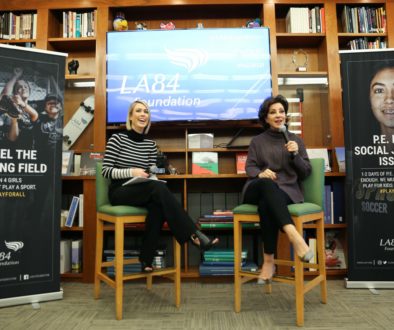SportsLetter Interview: Author Tom Farrey
In “Game On: The All-American Race to Make Champions of Our Children” (ESPN Books), journalist-author Tom Farrey examines the present-day culture of youth sports, where performance trumps participation and where younger and younger kids compete in tournaments and leagues. “There are 12-year-olds driving racecars,” Farrey writes. “Eleven-year-olds are turning pro in skateboarding. Ten-year-olds get recruited by college basketball programs. Nine-year-olds hire professional coaches. Eight-year-olds play 75 baseball games a year. Seven-year-olds vie for power-lifting medals. Six-year-olds have personal trainers. Five-year-olds play soccer year-round. Four-year-old tumblers compete at the AAU Junior Olympics. Three-year-olds enter their third year of swim lessons. Two-year-olds have custom golf clubs.”
Youth sports, Farrey argues, is an institution that is at a historic crossroads, and he travels the globe to contrast and compare the U.S. system with other countries. In so doing, he interviews countless kids and parents; administrators and coaches; and scientists and educators. His account is, at once, sobering and outraged. Concludes Farrey: “[Youth sports is] less and less accessible to the late bloomer, the genetically ordinary, the economically disadvantaged, the child of a one-parent household, the physically or mentally disabled, and the kid who needs exercise more than any other — the clinically obese.”
Farrey joined ESPN in 1996. He is an investigative reporter whose work has appeared in ESPN the Magazine, ESPN.com, “Outside the Lines,” and “E:60.” He has won two Emmy awards for outstanding sports journalism. Before joining ESPN, Farrey worked at the Seattle Times newspaper. This is his first book; see www.tomfarrey.com for more information.
Farrey spoke to SportsLetter, in August, from his home.
—- David Davis
SportsLetter: What prompted you to write this book?
Tom Farrey: I’m a father of three kids — a son, Cole, who’s 11; a daughter, Anna, who’s 9; and a son, Kellen, who’s 4. He’s the kid on the cover of the book, the one with in diapers. That means I spend my days and my weekends going to games and practices. I end up spending a lot of time thinking about kids in sports and what’s healthy and what’s productive. A lot is healthy and productive. I’ve seen some very good things. My kids have had some great coaches.
At the same time, I’ve seen some ominous trends that a lot of other parents have seen as well — most specifically, the fact that organized competition is being pushed down, down, down age-wise. I started playing organized ball — T-ball — when I was 7 or 8. Now, T-ball starts at age 5. Three-year-olds at the YMCA are running around in uniforms and playing 30-minute games of basketball and soccer. You feel pressure as a parent to get your kids involved early, or you feel like your kid could be left behind. There is the emergence of travel teams at the grade-school level, which has ramifications and implications for everybody, both for the kids who make the team and the kids who get pushed aside. It becomes very intense very quickly.
I began to wonder, “Gee, how did we get into this situation?” Because a lot of parents like myself see these themes and feel these pressures, but they don’t know exactly where they came from and how we got to this point. Nobody had really looked at this from a journalistic perspective. Well, my tool is investigative journalism: I know how to ask questions, I know how to find people who have answers, and I know how to put it together in readable manner. So, that’s what I did. I traveled all over the country — reporting from at least 15 different cities and involving families and kids in at least a half-dozen sports. I talked with experts, everyone from geneticists to psychologists to child-development experts to folks who know biological growth patterns.
SL: You write that many parents operate with the idea that, “it’s never too early to train children as competitors.” How did this idea become so prevalent in youth sports?
TF: It wasn’t too long ago that the cautionary tale of Marv and Todd Marinovich in Southern California was offered up as an example of why you don’t want to push your kid too hard or why you don’t want to try and manufacture an elite athlete. Which is exactly what Marv Marinovich tried to do with [his son] Todd. He had Todd doing certain exercises when he was very young and limited him to certain kinds of food that he could eat, with the hope that he would become a top-flight quarterback. Todd did make it to USC and the NFL. However, he flamed out in a haze of drugs. And, all of us learned a lesson from that.
Then, Earl and Tiger Woods came along and erased that whole lesson. Tiger is an impressive golfer and an impressive person — the kind of kid any parent would be proud of. A lot parents looked at that and said, “Well, if Earl can do that with Tiger, why couldn’t I do that with my kid?” This is natural for parents: they see a world of potential in their child and they want to bring it forth. Parents today feel that it’s their responsibility to bring out the greatness in their children, rather than just letting the kids find their own way and giving them the tools to figure out what is right for them.
So, Earl and Tiger Woods changed the whole paradigm across sports, not just in golf. I think that played a big role. But it goes well beyond Tiger. That’s why it took me 384 pages to get at it, because there are so many themes at play. There’s the rise in college scholarships — they’ve quadrupled since the early 1990s. There’s now $1.5 billion worth of athletic aid that’s handed out to recruited athletes every year. The rewards for athletic achievement have gone up.
At the same time, the penalties for failing to achieve athletically have gone up as well. We’re constantly reminded of the obesity crisis in this country. No one wants their kid to be inactive. And now you have middle schools, especially in large urban areas, that have cut their athletic budgets significantly. Intramurals are down, recess is down. Middle-school teams are being eliminated. Freshman teams at the high-school level are being eliminated. So, it’s gotten tougher to simply make your school team. Parents understand that, so they’re more willing to create select-based teams in grade school so that their kids can have an advantage as they move through the system.
SL: You write about the effects of specialization — someone like Tiger Woods, who concentrates on one sport to the exclusion of all others. Some parents argue that: “Hey, the earlier my kid learns a skill, like hitting a golf ball, the better.” What’s wrong with that thought process?
TF: It’s probably true that the earlier you start a kid on a particular sport, the better he’s going to be at age 10 or 12 or maybe even 15. But the hazards are that, by focusing on one sport, you risk mental exhaustion. If a kid has pretty much focused on one sport since he was very young, after 10 years he just wants to go play his guitar and chase girls. Also, because the kid is focusing on one sport, he risks overuse injuries because he’s using the same joints over and over. He’s stressing them.
There’s a tendency to think that the best way to create an athlete is to focus them on one sport early. It does give them some advantages, but ultimately it doesn’t create a better elite athlete. The research says that most of the best athletes in the country played multiple sports during their teenage years. Look at tennis, one of those sports where early specialization has been part of the culture for a while. And yet, Rafael Nadal and Roger Federer don’t follow that mode. They both played soccer into their teenage years. If you watch them play, the footwork that they learned in soccer is critical to their excellence as tennis players. Roger Federer is a large man who’s extremely graceful on the court. It all starts with his footwork. This didn’t come from focusing exclusively on tennis when he was young. It comes from picking up what we call “transferable skills.”
Here’s another example. Tony Gwynn went to San Diego State on a basketball scholarship. He was a point guard. Then, he began to focus on baseball. All the basketball he played didn’t put him behind. It actually helped him — and helped make him a Hall of Fame player — because, when he was hitting, he was so good at waiting until the last second for the pitch and then almost digging the ball out of the catcher’s glove. He had a relationship between the bat and his hands that was keen, and that relationship — that hand-eye coordination — started with him playing basketball.
SL: Have parents taken the kids — and what sports they want to play — out of the equation?
TF: Kids are now introduced to sports through their parents: they’re signed up for soccer at age 4, instead of playing soccer in the backyard with their friends and saying, “Hey, is there a team I can play on?” Kids aren’t even aware that baseball exists sometimes until they’re signed up for T-ball, they don’t know that soccer exists until they’re signed up for it. It’s more and more the parents’ choice.
If you look at the research, it’s critical for kids to fall in love with the game very early on. A romance is born that propels them to develop on their own. That’s when they go in the backyard and start playing with a ball. That’s what makes them go to YouTube and pull up some video of some great player — and then they try and copy the moves. That’s what makes them want to stay at practice extra long. The more it comes from the kids and the less it comes from the adults, the better athlete you’re going to create.
SL: On the one hand, there’s this competitive youth-sports culture that you write about, and yet children are now more obese than ever before. How do you reconcile that dichotomy?
TF: The argument that I make — and that I try to back up with as much research as is out there — is that the two trends are related. It has to do with our attempt to increasingly select out who we think are the best athletes at earlier and earlier ages. For instance we’ll create a third-grade travel soccer team. We’ll hold a tryout and pick the 12 or 14 kids that we think are the best. What that does is push aside the other kids, and those kids often don’t come back and try out the next year. They get the message; they move on.
When we select out athletes and create these travel teams, we’re effectively holding high-school tryouts in the third, fourth and fifth grades. What that does is push aside the kids who are late-bloomers physically, who simply haven’t grown into their body and won’t do so until they’re 12 or 13. It also pushes aside the kid from the single-family home whose mom can’t get him to all the tournaments and practices and games that are a long drive away. It also pushes aside the kid from the lower-income home who can’t afford the travel-team jackets and the tournaments that are one state away.
What activity options do they have? Well, they can continue to play rec soccer or baseball. But those leagues begin to wither very soon, and it’s typically not the rec teams that are feeding the high schools or even the middle schools with talent. So, if they don’t jump on the select-team — travel-team — path early on, then they get pushed aside.
SL: What happened to casual, unstructured play? What’s the benefit of unstructured play?
TF: The benefit of unstructured play is that it’s the children, and not the adults, who are making the decisions. There’s a chapter in the book on Jack Welch, the former CEO of General Electric. He played organized ball, but he didn’t play until he was a teenager. Until then, he and his buddies used to go down to the sandlot — they called it “the pit” — and get games together. That was a great environment for Jack Welch to develop not only as an athlete but a future leader. It was him who was working through the playground politics. It was him figuring out who was going to bat fourth in the lineup and who was going to pitch.
Today, it’s adults who are lining kids up on the field and telling them where to play and how to kick the ball up the field. Because it’s so organized, people are keeping score and keeping track of the league standings. Kids are less willing to experiment because it’s such a structured environment. They’re more likely to experiment in an unstructured environment. They’ll try stuff. If they’re less likely to try new things, they’re less likely to become better players.
SL: What did you learn from examining youth soccer?
TF: We have more kids in soccer uniforms than any nation in the world. And yet, in 30 years of trying, we’ve yet to produce one world-class soccer player. Not one. Why? Because it’s too organized and too focused on winning, as opposed to skill development. Technique — that relationship between the foot and the ball — ultimately is what makes better soccer players. If all kids learn is tactical play — “Okay, you’re the left fullback: whenever the ball comes to you, kick it to the outside and boot it up the wing and don’t dribble in front of the goal because someone might steal the ball and kick it in” — that means they’re always playing it safe. Their teams might win in the short term, but ultimately that doesn’t build a better soccer player.
In this country, surveys show that kids start dropping out of soccer at age 9 because they’re been in it for a few years. In Brazil, most kids don’t start to play organized soccer until age 9 or so. That’s when they wear uniforms, in many cases. And even after that happens, there’s a lot of unstructured play: kids kicking balls on concrete courts, on futsal courts, on beaches, in alleyways, with their grandpa. They’re infused with unstructured play, and they’re the most creative players in the world.
SL: Is U.S. Soccer trying to change the course on this?
TF: U.S. Soccer has acknowledged the shortcomings, the problems of trying to organize things at too early of an age. I give them a lot of credit. In their “best practices” document that came out recently, they make the case that coaches need to build more unstructured play into the practices. In effect, give the game back to the kids during the practices by creating several small-sided games. By giving minimal instructions and telling the kids, “You guys figure it out.” And then, stepping back. They don’t have to feel like they have to micromanage every situation. Instead, let the kids learn how to communicate with each other. Let them figure out the game because, ultimately, the game is the best teacher.
SL: Why have organized club teams begun to supersede organized school teams?
TF: Club teams create more of a consistent training environment than school teams do. School teams are typically single-season entities. The folks who coach the teams are often teachers at the school — P.E. teachers or English teachers — so they’re not necessarily fulltime coaches. Their energies are diluted.
With a club environment, you often get a professional coach whose job it is to develop players on a year-round capacity. They need to stay in business, so it becomes much more of an intense environment. They do end up dominating the scene. This is where college coaches typically look for talent now; with the exception of football, they look to the clubs, and the tournaments they play in, to aggregate the best talent. You have greater access to a college scholarship if you can afford to be in a club environment. And, parents understand that.
SL: Is this a positive development or a negative one?
TF: It’s positive when the coaching is age-appropriate and it’s focused on development more than winning tournaments. Unfortunately, coaches charging $2,000 a year to train soccer players feel like they need to win tournaments to justify the fees that they’re charging the parents because parents often evaluate success based upon winning tournaments. The coaches feel like they need to put the pelts up on the wall just to keep the money flowing. And, parents often don’t understand that the best thing for their kid is not to be declared a national or state champion at age 10, but to develop skills and techniques that will help them be a better player down the road.
SL: How does class enter into this equation — are wealthier families benefiting more from the current structure of youth sports than working-class families?
TF: Yes. These clubs cost money. A lower-income family simply cannot afford $2,000, maybe more, on a kid’s sports activity. So, you end up with a form of economic discrimination.
Again, soccer is a perfect example. Around the world, soccer is known as the game of poor people. In this country, it’s largely a suburban exercise. You end up pushing aside those kids from the homes that simply can’t afford it. Which is a great irony: How expensive should soccer be? All you need is a ball, a net, and a field. It’s not like ice hockey, which has a high barrier of entry.
SL: In California and other states, many schools have been forced to cut their sports programs because of the budget problems. What’s the long-term effect of this policy?
TF: The effect is that sports opportunities are focused on an increasingly smaller set of kids. You have more kids who don’t have a team to play on, and meanwhile they’re ingesting all these calories, fast food or otherwise, and they don’t have a way to burn off all these calories.
The schools need to figure out what is the mission of school sports. Is it to bring pride to the hometown by winning a state championship or is it to create a model of broad-based participation that develops lifetime fitness habits for the largest number of kids? Right now, they’ve taken the first path.
In the past, they were able to do both because, in addition to having the varsity team that pursued the state title, they had intramurals and freshman teams and recess. The environment has changed, and you just can’t assume that kids are going to find exercise.
SL: You ask the question in the book: “Has the success of a few come at the cost of many?” How would you answer that?
TF: I think it’s quite likely that the success of a few has come at the expense of many. We need more research done on youth sports in general. Specifically, we need research done in the area of travel teams and what happens when you begin to select out athletes at earlier and earlier ages. Anecdotally, I’ve seen how it pushes kids aside. I’ve seen it in my own family and in my own community. I don’t see how select teams for third-graders serves the need of the broadest set of kids.
SL: Do you blame anybody or any organization for this? The parents? The NCAA? The AAU? The Amateur Sports Act?
TF: People might want to over-simplify, but there’s no one villain. It’s the result of a confluence of events that have occurred in the past 15-20 years. Everybody bears some responsibility.
If there’s any one organization that stands out, it would be the NCAA, which has sponsored the growth of athletic scholarships and preferential admission for athletes. The NCAA, more than any other organization, has raised the rewards for athletic achievement because the increased number of college scholarships has encouraged the creation of select teams at earlier and earlier ages. Most parents don’t truly think that their child can be a pro athlete. A far more common thought is, “Oh, my kid seems to be pretty good at this sport. Maybe I can get him a college scholarship. That way I don’t have to pay for the rising cost of college.”
It does beg the question: should we have some kind of national coordinating body for youth sports? That body would fund research, so people would know what’s age-appropriate for their children; push coaches’ education down the pipeline across all sports; integrate the school and the club teams so that they’re not in conflict with each other; develop both great athletes and youth sports programs that develop character.
In most countries, there’s a minister of sport or a minister of youth. That person oversees the environment, and there’s some top-down leadership. Here, it’s completely helter-skelter. It’s a libertarian’s dream. There’s no leadership. Everybody’s in this manic, frenzied race to get their kids ahead — or, at least make sure they don’t fall behind.
SL: What positive steps have you seen in your travels for the book — any specific groups or coaches that are doing the right thing?
TF: I’ve seen more and more groups adapt coaches’ education. They’ve come to understand that everybody benefits if coaches know what they’re doing, not just technically and tactically in terms of teaching sports, but also communicating with the kids and making it a good experience for them.
In my town [in Connecticut], both the local soccer and Little League boards have brought in the Positive Coaching Alliance [from Palo Alto]. They work with coaches on how to make it a good experience for the kids with research-based teaching, such as the magic ratio. They let you know that, when coaching kids, if you aspire to a goal of five truthful, positive comments to every one critical comment, the kid is more likely to respond to you and to develop. The Bill Parcells-Bobby Knight model of coaching doesn’t work very well with kids of a certain age.
I’ve seen coaches who’ve gone through this training. They check themselves a little bit more, and they’re thinking about it. It promotes more of a participation-based model, rather than a pure performance-based model.
That type of teaching is critical. There’s no reason why any youth sports organization shouldn’t have their coaches go through such training because a lot of this can be done online now. It’s scaleable, and it’s not all that expensive.
SL: You traveled to France, Australia and Russia, among other countries, in researching this book. What do other countries do that you think we should emulate with youth sports?
TF: The first thing is, there’s no country out there that has completely nailed it. That said, the Scandinavian countries encourage more of what they call a “sport for all” philosophy — which I think is very healthy. The idea being that sport isn’t just for the elite, or who we think are the elite at a very young age. The idea is to keep participation as broad as possible and encourage kids to do as many different sports as possible. I think it would be great to adapt a “sport for all” philosophy at the federal level, the state level and the town level so that policies about, say, the allocation of playing fields are made accordingly.
Australia does some interesting things in the area called “talent identification.” They put kids through a battery of tests when they become teen-agers. They’ll tell them, “Hey, you have the perfect body for rowing. Have your considered that?” And, that opens up some avenues beyond the obvious sports and stokes some curiosity. That can keep kids involved in sports. And, who knows? Maybe they’re going to be very good at it. And that’s a key: Kids want to be good at something. If you identify a viable option for them, there’s a good chance that they’re going to stick to it.
Brazil, simply through its poverty and its culture that appreciates creativity, promotes unstructured play. It doesn’t over-organize things because they simply can’t afford uniforms and referees. I was in the Dominican Republic. We often say, “Well, the Dominican produces so many baseball players because they’re poor and desperate to get out.” But that’s only part of the equation. The fuller truth is that they develop players better than we do because they don’t focus so much on winning games as developing skills. They organize their system down there — the “buscones” [“the finders”] do — to teach the five tools to the kids. So, it’s a lot of batting practice, tons of grounders, a lot of repetition, and a very high practice-to-game ratio. The goal in Dominican baseball is to get to age 16 and be a five-tool player, so that when they go to the tryouts with the pro scouts, they can throw hard, hit hard, and run fast.
Here, on the other hand, our kids play an endless slate of games and tournaments. They’re constantly in game environments where they learn to win games, but they may only touch the ball three times in the course of three or four hours. It’s a very high game-to-practice ratio.
SL: You work for ESPN. Do you think that ESPN — in all its celebration of “Next” athletes — has played a role in the way youth sports have changed over the years?
TF: I think media in general is more interested in figuring out who is next. I think media is interested in that in part because college scouts are interested. People who follow pro leagues are interested in who is next. I mean, we now have college coaches scouting middle school basketball players. So, if that’s going to happen, the media is going to follow. The media is not making coaches show up at these middle-school tournaments and exposure camps. I think it’s driven by the industry, and then the media becomes a reflection of that.
SL: Does your book attack the very industry — sports — that you work for?
TF: I think it’s a very honest critique of the entirety of the sports industry. Everyone in this space gets a scrubbing — an honest and fair scrubbing. Most people who’ve read the book — even folks whose organizations have been criticized — have appreciated its findings. I mean, what’s to argue with: we want as many kids playing sports, as long as possible, because that’s going to lead to a healthier nation. And, for the industry itself, it’s going to lead to more people who have an affection for sports and who can then become the next generation of fans and consumers. So, I think everyone in this space — the professional leagues, the colleges, high schools and middle schools, parents, media — have an interest in moving toward a “sport for all” model.
SL: How do you view the future for youth sports?
TF: I see some good things. I see that coaches’ education is going to be more common, and I think that’s a healthy development.
I also see organized competition pushing down, down, down in age groups because there will always be some parents who believe that if an 8-year-old wins some tournament, it’s a good thing. You have to remember: youth sports is an industry, it’s a business. If there are x number of parents who want to read rankings of fifth-grade basketball players, someone is going to provide that and take their money. If there are x number of parents who believe that getting their kids into a sports camp at age 6 is going to give them an advantage, there’s someone who’s going to take their money.
The only thing that will control that is lots of research that delineates the pluses and minuses of competition at such an early age and pushing that knowledge down the pipeline to coaches and administrators so that they can begin to structure their sports leagues and associations in a way that really does benefit the kids.




